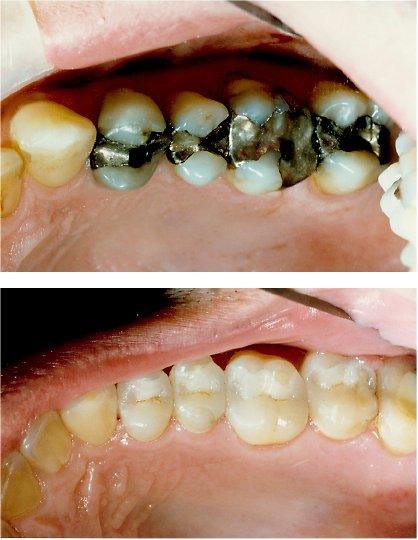White / Composite Fillings
What are dental fillings?
Dental fillings are used to repair cavities, caused by tooth decay, and teeth that have been worn down or cracked. Fillings help to restore the function and shape of your teeth, while preventing further decay and infection.
What are the different types of dental fillings?
Numerous materials are used for dental fillings, including:
- Gold — Resilient and well-tolerated by the gums, gold is considered to be the best filling material, however, it is expensive.
- Porcelain — Porcelain fillings, often used in inlays and onlays, can be matched to the color of your teeth and will resist stains. Like gold, however, they are quite costly.
- Silver amalgam — Silver amalgams are resilient and inexpensive, but are shunned by some patients due to their relatively dark color.
- Composite resin — Composite resin can be matched to the color of your teeth for a natural appearance, but lacks the resilience of other fillings. This type of filling is usually recommended for small areas of decay or damage.
- Glass ionomer: Glass ionomers are composed of silicate glass powder and polyalkenoic acid (an ionomer). It is most commonly used as cement for inlay fillings, fillings in the front teeth, around the necks of the teeth, or in the roots.
The type of filling used will be determined by your dentist and depend on the extent of your decay or damage. Price may also be a factor.
What is the procedure for getting a dental filling?
In the event of decay or damage, your dentist will make the determination about which filling material to use. A local anesthetic is administered to numb the area. The dentist will use a drill or laser to remove the decay, probing the region with metal instruments to ensure that all of the decay has be
en removed. The cavity will be cleaned of bacteria and debris with an air/water unit. If the decay is deep and near the root, your dentist may line the area with filling materials first to protect the nerve. After the filling is put in place, the process is finalized with a polish.
Since there are different materials used for fillings, the procedure may vary. If tooth- colored material is used, the filling is applied in layers and then hardened with a special curing light. The material will then be shaped, trimmed and polished.
Why are fillings necessary?
Fillings are necessary to prevent infection. Cavities create holes in your teeth, which can allow harmful bacteria to enter the inside of your tooth. Bacteria left inside a cavity can cause severe tooth decay and infection. By filling your decayed teeth, the dentist removes the bacteria and closes up cavities to prevent the bacteria from re-entering the tooth.
Fillings can also help to repair cracked or chipped in order to preserve the natural tooth. In such cases, fillings may help to prevent the need for more extreme measures of restoration.

